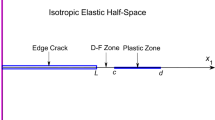Abstract
The behavior of dynamic emission of dislocations from the tip of a stationary crack under mode II or mode III loading is examined. A critical stress intensity factor, K D is assumed for dislocation emission. After emission, the dislocation moves with a velocity which varies with the effective shear stress to the third power. The effective shear stress is due to the applied stress σ, modified by the presence of the crack and all other dislocations minus the lattice friction stress, τF. The effects of K D, σ, and τF on the rate of emission, the plastic zone strain rate, the plastic zone size, the dislocation distribution, and the dislocation-free zone are reported.
Résumé
On a examiné le comportement d'une émission dynamique de dislocations depuis l'extrémité d'une fissure stationnaire. On suppose que l'émission de dislocations est caractérisée par un facteur critique d'intensité de constrainte K D. Après son émission, la dislocation se meut avec une vitesse qui varie avec le cube de la constrainte effective de cisaillement. Celle-ci résulte de la constrainte appliquée σ, modifiée par la présence de la fissure et de toutes les autres dislocations, et sous déduction de la contrainte de friction du réseau, τF.
On étudie les effects de K D, σ et τF sur la vitesse d'émission des dislocations, la vitesse de déformation plastique, la taille de la zone plastique, la distribution des dislocations, et sur la zone qui en est dépourvue.
Similar content being viewed by others
References
S. Kobayashi and S.M. Ohr, Philosophical Magazine A 42 (1980) 763–772.
S. Kobayashi and S.M. Ohr, Scripta Metallurgica 15 (1981) 343–348.
Idem, in 37th Annual Proceedings Electron Microscopy Society of America, San Antonio, Texas, edited by G.W. Bailey (1979) 424–425.
S.M. Ohr and S. Kobayashi, Journal of Metals 32 (1980) 35–38.
B.A. Bilby, A.H. Cottrell and K.H. Swinden, Proceedings of the Royal Society A 272 (1963) 304–314.
J.C.M. Li, in Dislocation Modelling of Physical Systems, edited by M.F. Ashby et al., Pergamon (1981) 498–518. In that paper, Eq. (9) should have a factor l/(x+l) multiplied to the last term; (11) should have % MathType!MTEF!2!1!+-% feaafiart1ev1aaatCvAUfeBSjuyZL2yd9gzLbvyNv2CaerbuLwBLn% hiov2DGi1BTfMBaeXatLxBI9gBaerbd9wDYLwzYbItLDharqqtubsr% 4rNCHbGeaGqiVu0Je9sqqrpepC0xbbL8F4rqqrFfpeea0xe9Lq-Jc9% vqaqpepm0xbba9pwe9Q8fs0-yqaqpepae9pg0FirpepeKkFr0xfr-x% fr-xb9adbaqaaeGaciGaaiaabeqaamaabaabaaGcbaWaaOaaaeaaca% WGSbGaai4laiaadIhacaGGNaaaleqaaaaa!3954!\[\sqrt {l/x'} \]changed to % MathType!MTEF!2!1!+-% feaafiart1ev1aaatCvAUfeBSjuyZL2yd9gzLbvyNv2CaerbuLwBLn% hiov2DGi1BTfMBaeXatLxBI9gBaerbd9wDYLwzYbItLDharqqtubsr% 4rNCHbGeaGqiVu0Je9sqqrpepC0xbbL8F4rqqrFfpeea0xe9Lq-Jc9% vqaqpepm0xbba9pwe9Q8fs0-yqaqpepae9pg0FirpepeKkFr0xfr-x% fr-xb9adbaqaaeGaciGaaiaabeqaamaabaabaaGcbaWaaOaaaeaaca% GGOaGaamiBaiabgUcaRiaadIhacaGGNaGaaiykaiaac+cacaWG4bGa% ai4jaaWcbeaaaaa!3D37!\[\sqrt {(l + x')/x'} \]in two places and should have a factor % MathType!MTEF!2!1!+-% feaafiart1ev1aaatCvAUfeBSjuyZL2yd9gzLbvyNv2CaerbuLwBLn% hiov2DGi1BTfMBaeXatLxBI9gBaerbd9wDYLwzYbItLDharqqtubsr% 4rNCHbGeaGqiVu0Je9sqqrpepC0xbbL8F4rqqrFfpeea0xe9Lq-Jc9% vqaqpepm0xbba9pwe9Q8fs0-yqaqpepae9pg0FirpepeKkFr0xfr-x% fr-xb9adbaqaaeGaciGaaiaabeqaamaabaabaaGcbaWaaOaaaeaaca% GGOaGaamiEaiaacEcacqGHRaWkcaWGSbGaaiykaiaac+cacaGGOaGa% amiEaiabgUcaRiaadYgacaGGPaaaleqaaaaa!3FB8!\[\sqrt {(x' + l)/(x + l)} \]multiplied to the last term; then starting from (12), the condition l≫x applies.
Shu-Ho Dai and J.C.M. Li, Scripta Metallurgica 16 (1982) 183–188.
S.J. Chang and S.M. Ohr, Journal of Applied Physics 52 (1981) 7174–7181.
S.J. Chang and s.M. Ohr, in Dislocation Modelling of Physical Systems, edited by M.F. Ashby et al., Pergamon (1981) 23–27.
B.S. Majumdar and S.J. Burns, International Journal of Fracture 21 (1983) 229–240.
N.P. Louat and J.R. Griffiths, Scripta Metallurgica 16 (1982) 765–767.
N.P. Louat, Scripta Metallurgica 16 (1982) 775–779.
Author information
Authors and Affiliations
Rights and permissions
About this article
Cite this article
Zhao, RH., Dai, SH. & Li, J.C.M. Dynamic emission of dislocations from a crack tip — a computer simulation. Int J Fract 29, 3–20 (1985). https://doi.org/10.1007/BF00020673
Received:
Revised:
Issue Date:
DOI: https://doi.org/10.1007/BF00020673




